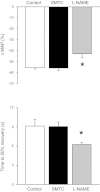Effects of neuronal nitric oxide synthase inhibition on microvascular and contractile function in skeletal muscle of aged rats
- PMID: 22923618
- PMCID: PMC3469646
- DOI: 10.1152/ajpheart.00477.2012
Effects of neuronal nitric oxide synthase inhibition on microvascular and contractile function in skeletal muscle of aged rats
Abstract
Advanced age is associated with derangements in skeletal muscle microvascular function during the transition from rest to contractions. We tested the hypothesis that, contrary to what was reported previously in young rats, selective neuronal nitric oxide (NO) synthase (nNOS) inhibition would result in attenuated or absent alterations in skeletal muscle microvascular oxygenation (Po(2)(mv)), which reflects the matching between muscle O(2) delivery and utilization, following the onset of contractions in old rats. Spinotrapezius muscle blood flow (radiolabeled microspheres), Po(2)(mv) (phosphorescence quenching), O(2) utilization (Vo(2); Fick calculation), and submaximal force production were measured at rest and following the onset of contractions in anesthetized old male Fischer 344 × Brown Norway rats (27 to 28 mo) pre- and postselective nNOS inhibition (2.1 μmol/kg S-methyl-l-thiocitrulline; SMTC). At rest, SMTC had no effects on muscle blood flow (P > 0.05) but reduced Vo(2) by ∼23% (P < 0.05), which elevated basal Po(2)(mv) by ∼18% (P < 0.05). During contractions, steady-state muscle blood flow, Vo(2), Po(2)(mv), and force production were not altered after SMTC (P > 0.05 for all). The overall Po(2)(mv) dynamics following onset of contractions was also unaffected by SMTC (mean response time: pre, 19.7 ± 1.5; and post, 20.0 ± 2.0 s; P > 0.05). These results indicate that the locus of nNOS-derived NO control in skeletal muscle depends on age and metabolic rate (i.e., rest vs. contractions). Alterations in nNOS-mediated regulation of contracting skeletal muscle microvascular function with aging may contribute to poor exercise capacity in this population.
Figures






Similar articles
-
Role of neuronal nitric oxide synthase in modulating microvascular and contractile function in rat skeletal muscle.Microcirculation. 2011 Aug;18(6):501-11. doi: 10.1111/j.1549-8719.2011.00111.x. Microcirculation. 2011. PMID: 21535296
-
Effects of chronic heart failure on neuronal nitric oxide synthase-mediated control of microvascular O2 pressure in contracting rat skeletal muscle.J Physiol. 2012 Aug 1;590(15):3585-96. doi: 10.1113/jphysiol.2012.235929. Epub 2012 Jun 11. J Physiol. 2012. PMID: 22687613 Free PMC article.
-
Role of neuronal nitric oxide in the inhibition of sympathetic vasoconstriction in resting and contracting skeletal muscle of healthy rats.J Appl Physiol (1985). 2013 Jul 1;115(1):97-106. doi: 10.1152/japplphysiol.00250.2013. Epub 2013 May 2. J Appl Physiol (1985). 2013. PMID: 23640592
-
Neuronal nitric oxide synthase and human vascular regulation.Trends Cardiovasc Med. 2009 Nov;19(8):256-62. doi: 10.1016/j.tcm.2010.02.007. Trends Cardiovasc Med. 2009. PMID: 20447567 Free PMC article. Review.
-
Skeletal muscle capillary function: contemporary observations and novel hypotheses.Exp Physiol. 2013 Dec;98(12):1645-58. doi: 10.1113/expphysiol.2013.073874. Epub 2013 Aug 30. Exp Physiol. 2013. PMID: 23995101 Free PMC article. Review.
Cited by
-
Nitric oxide synthase inhibition with N(G)-monomethyl-l-arginine: Determining the window of effect in the human vasculature.Nitric Oxide. 2020 Nov 1;104-105:51-60. doi: 10.1016/j.niox.2020.09.001. Epub 2020 Sep 24. Nitric Oxide. 2020. PMID: 32979497 Free PMC article.
-
Neuronal nitric oxide synthase regulation of skeletal muscle functional hyperemia: exercise training and moderate compensated heart failure.Nitric Oxide. 2018 Apr 1;74:1-9. doi: 10.1016/j.niox.2017.12.008. Epub 2017 Dec 27. Nitric Oxide. 2018. PMID: 29288804 Free PMC article.
-
Neuronal nitric oxide synthase inhibition and regional sympathetic nerve discharge: implications for peripheral vascular control.Respir Physiol Neurobiol. 2013 May 1;186(3):285-9. doi: 10.1016/j.resp.2013.02.021. Epub 2013 Feb 27. Respir Physiol Neurobiol. 2013. PMID: 23454026 Free PMC article.
-
Muscle fibre-type dependence of neuronal nitric oxide synthase-mediated vascular control in the rat during high speed treadmill running.J Physiol. 2013 Jun 1;591(11):2885-96. doi: 10.1113/jphysiol.2013.251082. Epub 2013 Mar 18. J Physiol. 2013. PMID: 23507879 Free PMC article.
-
Nitric oxide and skeletal muscle contractile function.Nitric Oxide. 2022 May 1;122-123:54-61. doi: 10.1016/j.niox.2022.04.001. Epub 2022 Apr 8. Nitric Oxide. 2022. PMID: 35405336 Free PMC article. Review.
References
-
- Altman PL, Dittmer DS. Biology Data Book. Bethesda, MD: FASEB, 1974
-
- Bailey JK, Kindig CA, Behnke BJ, Musch TI, Schmid-Schoenbein GW, Poole DC. Spinotrapezius muscle microcirculatory function: effects of surgical exteriorization. Am J Physiol Heart Circ Physiol 279: H3131–H3137, 2000 - PubMed
-
- Baker DJ, Krause DJ, Howlett RA, Hepple RT. Nitric oxide synthase inhibition reduces O2 cost of force development and spares high-energy phosphates following contractions in pump-perfused rat hindlimb muscles. Exp Physiol 91: 581–589, 2006 - PubMed
-
- Behnke BJ, Delp MD, Dougherty PJ, Musch TI, Poole DC. Effects of aging on microvascular oxygen pressures in rat skeletal muscle. Respir Physiol Neurobiol 146: 259–268, 2005 - PubMed
Publication types
MeSH terms
Substances
Grants and funding
LinkOut - more resources
Full Text Sources
Medical

